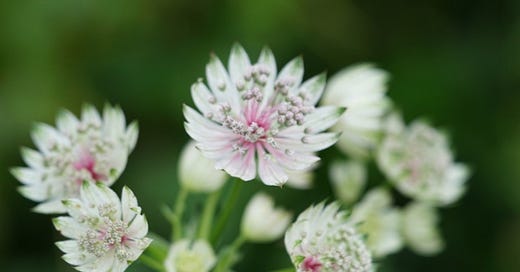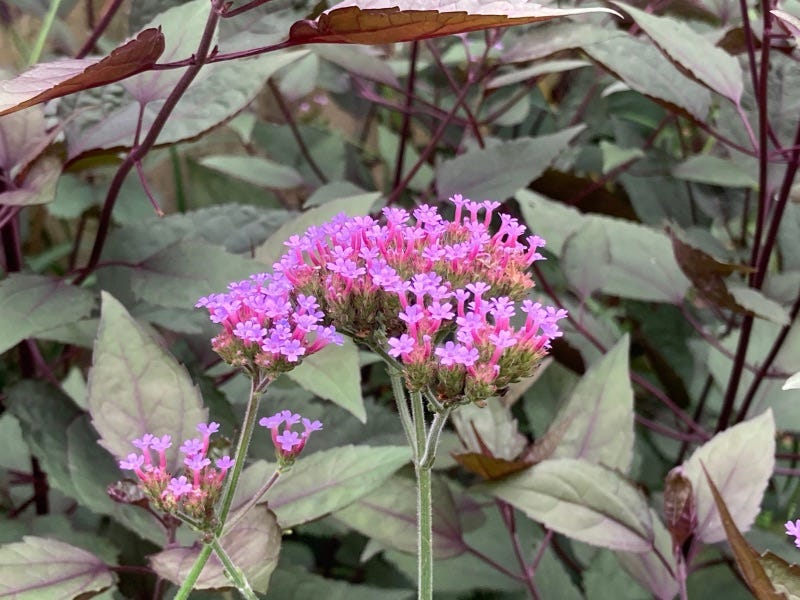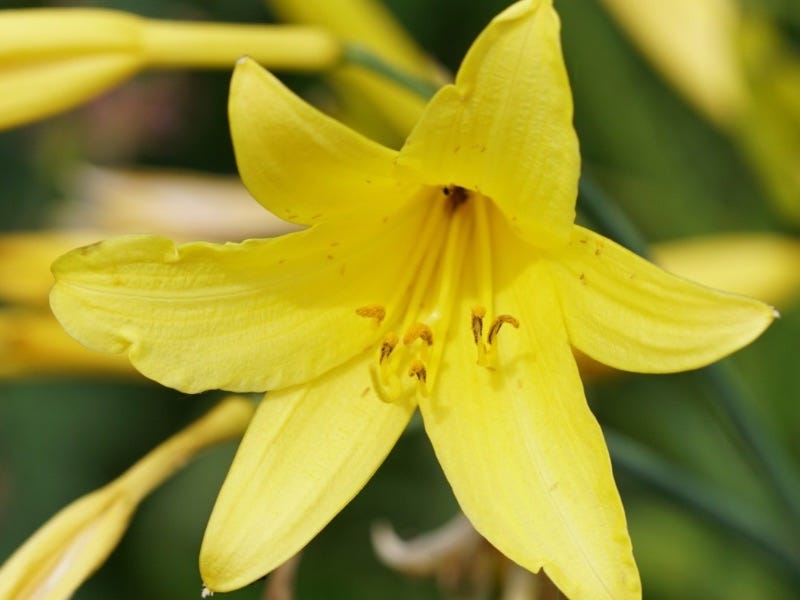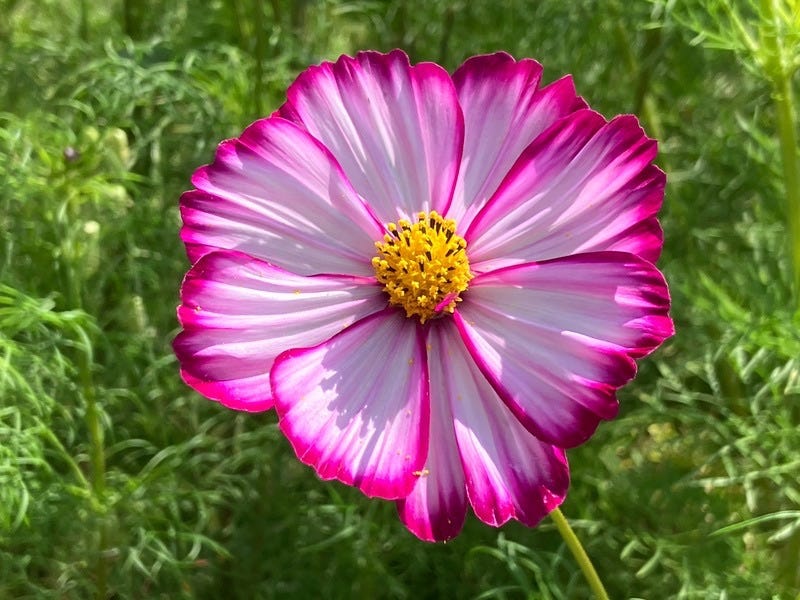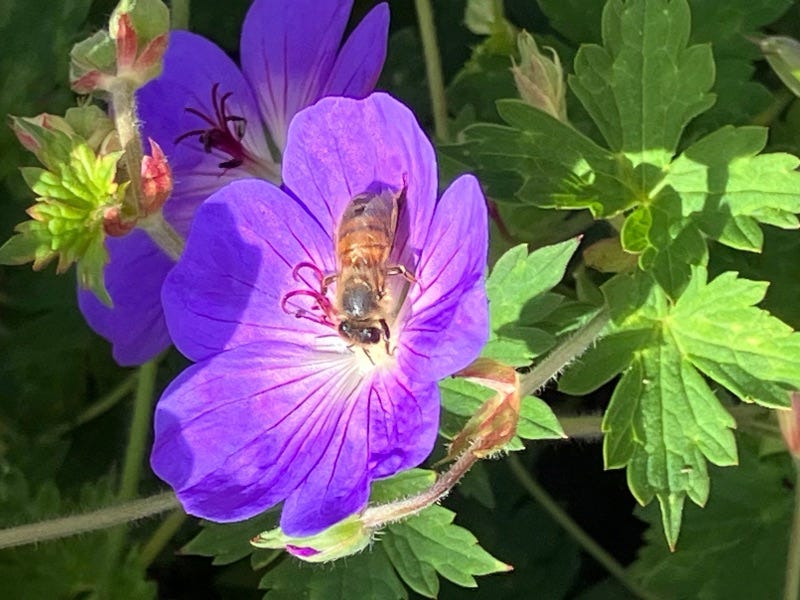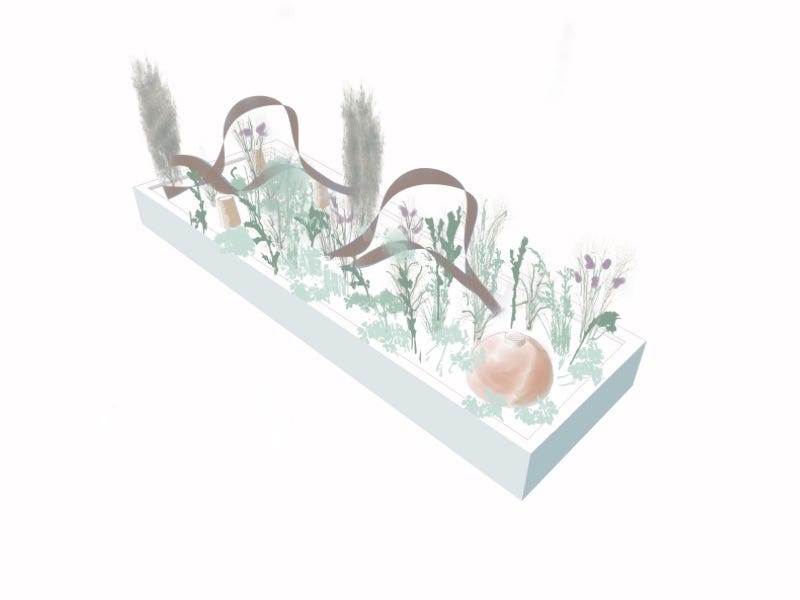What’s looking good
The magenta flowers of Knautia Macedonia bloomed a lot earlier this year but are still going strong. The roses and geraniums too, have been amazing this year, having produced several flushes of flowers already. The delicate blush of Astrantia ‘Buckland’ are happily flowering for months on end. Behind the astrantias, the darker foliage of Actaea simplex with its arching spires of white flowers (yet to bloom) and Ageratina altissima ‘Chocolate’, are really coming to the fore, this month.
In the free draining borders lavender is buzzing with the happy hum of bees, along with the pink and white daisies of Erigeron karvinskianus (Mexican fleabane). With the taller, lilac flowers of Verbena bonariensis, swaying in the breeze. Further down the garden, the cheerful yellow daylilies (Hemerocallis) are starting to make an appearance, amongst the thalictrums, asters and agapanthus.
Having enjoyed more evenings in the garden, this year, the scent of the honeysuckle and jasmine has been amazing. Near the house there is a cream coloured jasmine (Devon Cream) and at the opposite end, around a bench is a fence smothered in honeysuckle. We are enjoying the amazing scent and the night time pollinators are happy to have a readily available food supply.
Aftercare tips
The continued rain along with a few bursts of sun, at least here in the UK has meant many gardens have filled out in every direction, plants and weeds alike.
Deadheading roses: One of my favourite things to do, in an evening while dinner is cooking. It gives me a little time in the garden, space to think and cut back the roses, to keep the flowers coming until late autumn. I will wander round the garden, deadheading any plants that need it, at this time of year.
Cutting back geraniums: Many varieties can be cut back, to encourage a fresh flush of flowers. It is worth feeding the geraniums after cutting them back. My go to plant food is liquid seaweed, good for the plants without harming the wildlife.
Mulching: After planting up a garden I’ll always add a layer of mulch to help keep the weeds down and stop the water evaporating too quickly. With all the hot weather, if the garden hasn’t been mulched in a while (ahem, speaking for myself) it is worth thinking about adding some to the borders this month.
Watering: In hot weather, planters will need keep an eye on and topping up with water. Any newly planted trees, shrubs or perennials will need regular watering. To keep water use to a minimum, water plants at the base, rather than using a sprinkler. Depending on the size of the garden, it can be worth thinking about putting an irrigation system in. They will soak the roots and they come with a timer, to help keep water use to a minimum.
Rainwater harvesting: With more droughts being declared, rainwater harvesting systems are becoming increasingly important. These can be as basic as a water butt attached to a downpipe, to underground systems that are buried in the borders and collect rain and grey water from the house, to be used on the garden.
Trends
Xeriscaping: I wrote about the trend a year ago and with the drought we are having this year, it is becoming increasingly important. When adding new plants to the garden, it is worth choosing plants that suit the soil type, how free draining or water logged the garden is. Drought tolerant plants such as achillea (yarrow), cosmos and lavender are very happy with only a little water. The Mediterranean Garden at Beningbrough Hall, designed by Andy Sturgeon is a superb local resource. The garden has been planted in shallow soil, rubble and gravel, mainly choosing Mediterranean plants. If it rains all winter, the roots won’t get waterlogged and during hot summers the plants will thrive in the heat. The National Trust see this garden as an experiment, watching how the plants cope. It will be good to go back and visit each year, to look at which plants are thriving.
Wildlife: Wildlife friendly gardens that think about food and shelter are increasingly being considered. Spaces that we can enjoy alongside nature. Leaving the garden, a little less formal and not worrying too much about clearing up leaves, creates hiding spaces for insects. Plants, that flop over in the borders or onto the lawn, will create welcome shade from the heat of the midday sun. As will a branch on a tree or a shrub to perch on. In the hot weather the one thing insects, birds and hedgehogs all want is a water source. A shallow dish with a few pebbles or a small rock in, to help any insects get out, is ideal.
What I’m working on
This month I’ll be at the RHS Wentworth Woodhouse show, it is usually at Tatton but this year they have moved it to South Yorkshire. I have designed a garden for the long border category. It is in collaboration with York Gin, the theme being botanicals, many of which are grown in the gardens around York Minster. The colour palette celebrates York’s chocolate and Yorkshire’s rhubarb heritage. Two of the gin flavours are chocolate and orange, in celebration of the famous chocolate orange, and Yorkshire rhubarb. Chocolate named plants with orange geums and plenty of pink flowers to tie in with the rhubarb.
The sculpture comes in three parts, the CorTen steel ribbons weaving their way between two juniper trees towards the top of a copper gin still. As well as showcasing Yorkshire’s heritage, I’m hoping it will provide the visitors with ideas, mixing a tree or two, under planted with fruit, herbs and plenty of flowers. Planting ideas that can be considered, even in a small space, a border or a large planter. If you are thinking of visiting the show, please come and say hi.

